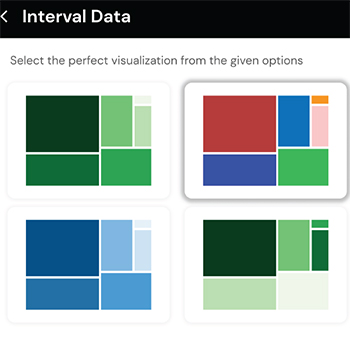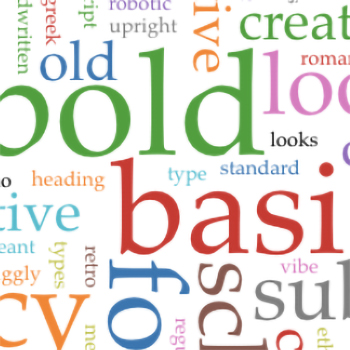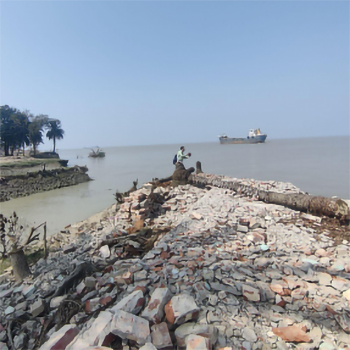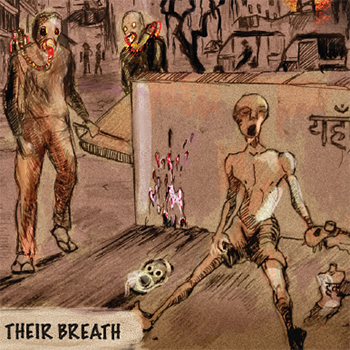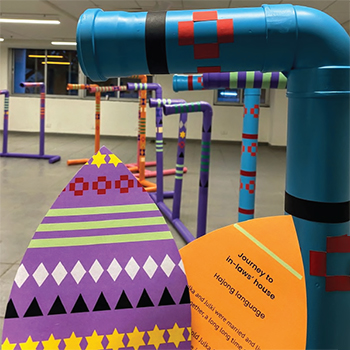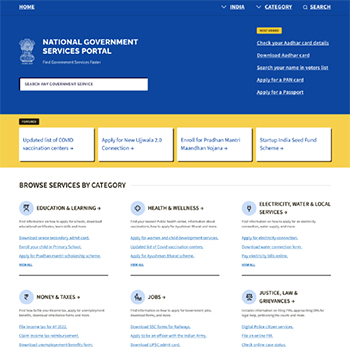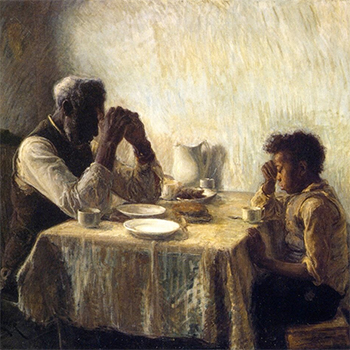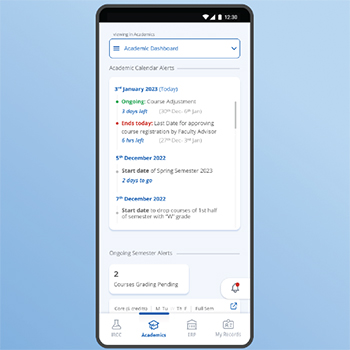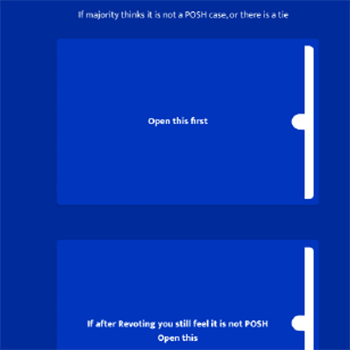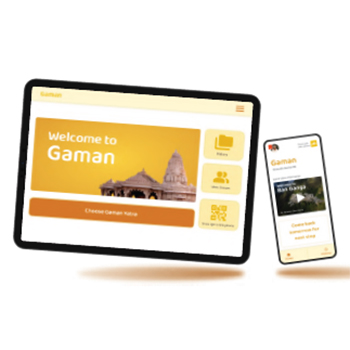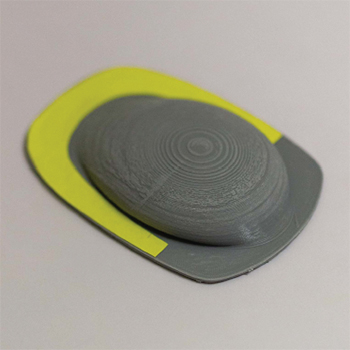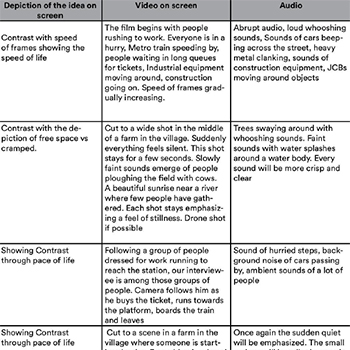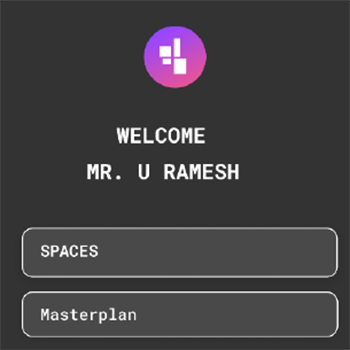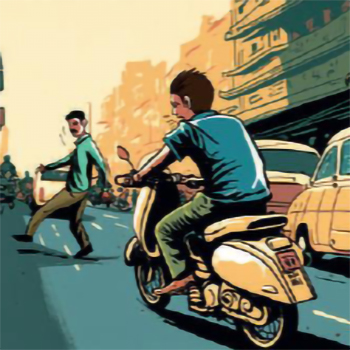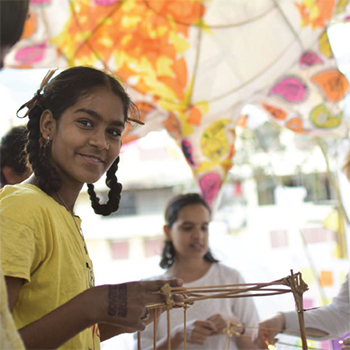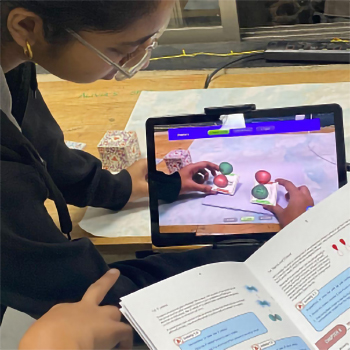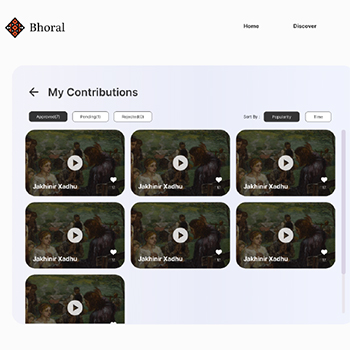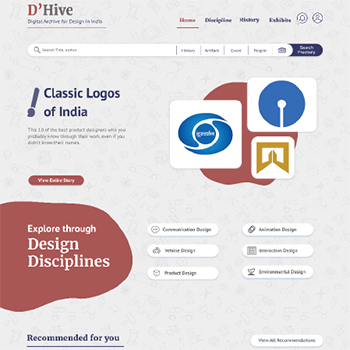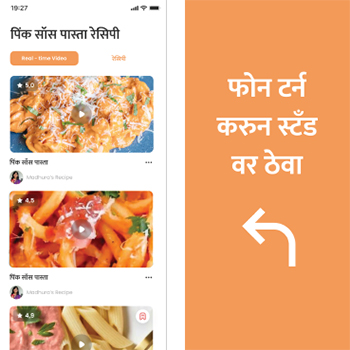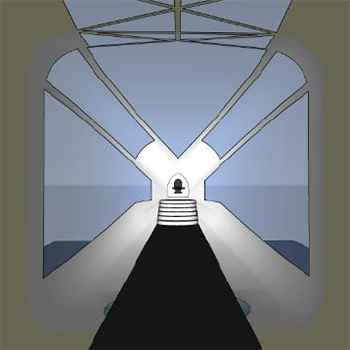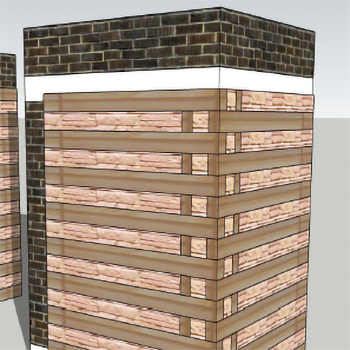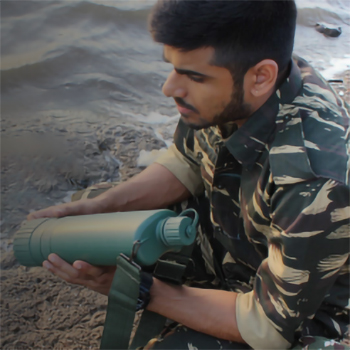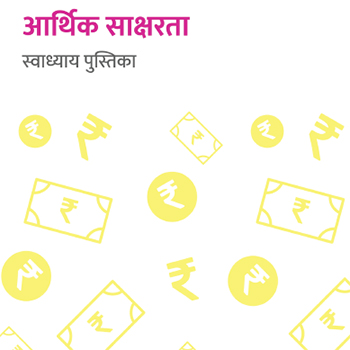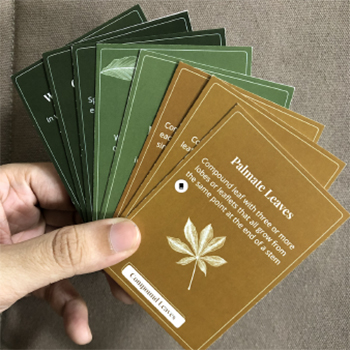M.Des Interaction Design 2019-onwards
2021-2023
(47 items)
Visually Representing Deep Time: An Attempt at Understanding the Cause-and-Effect Relationships leading to Evolution of Life on Earth
by Abhinav Bansal
by Abhinav Bansal
The project aims at the concept of deep time and understanding the cause-and-effect relationships that led to the evolution of life by using interactive data visualization. The visualizations are exploratory and data-driven. Deep time refers to the life of the earth, which is accepted to be 4.56 billion years in age. The human mind can easily visualise timescales of smaller range. However, as soon as this scale is increased, this understanding diminishes. I break down entire geologic time into 8 chapters and use a narrative and a metaphor of 80 years of human life to bind these chapters together. I designed different visualisations for each chapter; however, the semantics were kept constant throughout.
Details >>Design in Schools: Using Design Thinking Process to teach concepts of Mathematics in the Preparatory Stage of Schooling
by Abhinav Bansal
by Abhinav Bansal
The project aims to curate a framework for teaching mathematical concepts to elementary school students using the design thinking process. The project follows an iterative approach, where the engagement and learning outcomes of the process and designed activities are studied for subsequent development, culminating in a series of lesson plans for the identified topics. The activities are proposed as complimentary teaching methods rather than substitutes for existing mechanisms of teaching. Through the field study, we identified the current teaching methods and the conceptual difficulty the students face. We prepared a set of activities using the design thinking methodology and conducted a pilot study. The results were evaluated by domain experts, following which we designed our first draft of lesson plans and further tested them out using 3 different teaching methodologies. We found out that although traditional teaching mechanisms produced better overall results than a purely experience-based design thinking process, there were certain areas of application where the exploratory approach worked better. Based on the observations and another set of feedback, we designed the final lesson plan and activity workbook, combining theory-based teaching with experiential learning. Overall, we aim to enhance the teaching of mathematics by offering innovative activities and lesson plans, driven by research, testing, and expert evaluation.
Details >>Designerly reflections on data visualization Changing environment and its impact on Ghoramara Island, Sundarbans
by Alivia Chaudhuri
by Alivia Chaudhuri
In recent years, the delta of the Sundarbans has experienced various climate-related challenges, including rising sea levels, erosion of islands, and severe cyclones. These changes have had far-reaching effects, especially on the people living there. We visualise the data of one such island in the Indian Sundarbans delta, severely affected by erosion, known as Ghoramara island. Through an examination of the available scientific literature and a brief field study, this paper seeks to provide a comprehensive visual overview of the current state of the climatic parameters of the area and its environmental refugees targeted toward policymakers. This paper is a designerly reflection on the data visualisation we created on the same.
Details >>Font search and selection strategies of non-experts
by Alivia Chaudhuri
by Alivia Chaudhuri
The process of choosing a suitable font is challenging. There are numerous options to browse and select from. MyFonts website, one of the top digital font distributors, currently reports it has more than 133,000 fonts available. Google Fonts has a repository of 1462 open-source font families. Even an average computer running Microsoft Office has 164 standard fonts installed. Previously, access to typography was traditionally limited to typographers, designers, or specialists. Now in the post-digital era, access to fonts has risen significantly, which has led to the democratisation of type. Not only expert designers but also non-experts, i.e., novice users without design training, can access graphic design tools like Canva, Adobe Express, and font libraries by aggregators like Google Fonts and Adobe Fonts, which provide users access to thousands of fonts. Font search and selection can be especially difficult for non-designers because of the overwhelming number of options available. They may not be familiar with the classification terminologies associated with typefaces or the role they play in design. Thus, studying their interaction with font search menus becomes an important activity in user interface design. This project aims at studying the font search and selection strategies of non-expert users—with a focus on the usability of font search menu organisations (font classification), understanding how users decide the appropriateness of fonts and the relationships they associate with them.
Details >>Visualizing ecological change in the context of Indian Sundarbans
by Alivia Chaudhuri
by Alivia Chaudhuri
In recent years, the Sundarbans Delta has faced numerous accelerating climate-related challenges, including rising sea levels, island erosion, and increasing temperatures. These changes have had far-reaching effects, particularly on economically disadvantaged and marginalised communities residing in the area. To provide a comprehensive overview of the current state of the Indian Sundarbans delta, we conducted a brief field study, examined available peer-reviewed scientific literature, and consolidated data from various sources to shape a compelling narrative. We designed relevant visualisations that engage and inform the user. Our target audience is the general public, who read national English newspapers and possess a basic understanding of science, mathematics, and geography. The expected outcome is a website that presents the story and effectively conveys insights through interactive data visualizations. Our aim is to increase awareness about the ecologically significant Sundarbans and foster the audience's understanding of the impacts of climate change.
Details >>Every breath you take : Attempting to learn the art of creating graphic novels
by Amit Kumar Ram
by Amit Kumar Ram
This project is a continuation of a short graphic novella that I created as part of my trends in interaction design course. It depicted a world plagued by the scarcity of breathable air, exacerbated by an unchecked corporate desire for profit. In this world, air is traded like any other commodity, bought and sold in different qualities and quantities. Rich individuals lead vastly different lives from the poor. I wanted to improve the quality of my novella and therefore set out exploring and studying other graphic novels. I experimented with art styles to decide upon one for the final outcome of my exploration—adapting a few pages from George Allan England’s novel, “The Air Trust," which explores similar themes of capitalising on air scarcity.
Details >>Designing a service to improve the physical and psychological wellbeing of Thalassemic patients in rural India
by Amit Kumar Ram
by Amit Kumar Ram
Thalassaemias are one of the most common blood-related genetic disorders globally. India has a huge number . of thalassemic patients, around 100,000 patients with thalassaemia syndrome. Of the 10,000 to 12,000 thalassemic children born annually in India, very few are well taken care of, especially in urban regions. Thalassaemia patients require regular attention throughout their ives. They need to be on top of all necessary medical processes and need ways to ensure their monthly transfusion happens. The majority of the parents from rural areas and coming from low-income households are unaware of the process involved. The objective is to help Thalassaemia patients and their parents keep track of all the medical procedures relevant to them, get accessible treatment regularly, and also ensure their psychological well-being.
Details >>Constructing a physical installation to increase awareness about the endangered cultural elements of North East India
by Amit Kumar Ram
by Amit Kumar Ram
North East India is known for its rich cultural heritage, and this is reflected in the diversity of its people. This region is home to a number of different ethnic groups and cultures, each with their own unique traditions and languages. However, today many of these languages face the risk of extinction—and therefore, intangible cultural elements strongly intertwined with language, like folktales or folk songs, face a similar risk. The Northeast region has around 220 languages. Assamese, an IndoAryan language, is widely spoken in the Brahmaputra Valley of Assam and is the main language of many communities. Nagamese and Nefamese, both Assamese-based pidgin, are spoken in Nagaland and Arunachal Pradesh, respectively. Bengali is also widely spoken in lower Assam and Tripura. Nepali is widely spoken in Sikkim. However, there are numerous endangered languages that are difficult to preserve because of the lack of a proper script or lack of concerted efforts. In 2003, UNESCO recognised the need for preserving a region’s intangible cultural heritage, manifested through oral traditions, performing arts, social practices, rituals and festivals, knowledge and practices regarding the nature of the universe, and traditional craftsmanship. As a consequence, the Convention for the Safeguarding of Intangible Cultural Heritage was adopted by UNESCO.
Details >>Hows India doing?: Visualizing the National Family Health Survey (NHFS) reports
by Ankit Anand
by Ankit Anand
The National Family Health Survey is a nationwide survey conducted by the Ministry of Health and Family Welfare, Government of India. The survey provides information on population, health, and nutrition for India, each state/union territory (UT), and for 707 districts. The primary objective of the National Family Health Surveys is to provide essential data on health and human development indicators for individuals and households at the national and state levels. In this project, I will be visualising selected data from the NHFS-3, NHFS-4, and NHFS-5 reports to show India performs on these important health indicators and also chart the progress that has been made on these indicators at the national and state level. Visualising the data from the report will help the readers to identify important trends and patterns and make the data easier to recall.
Details >>Redesign of the National Government Services Portal
by Ankit Anand
by Ankit Anand
This is a project to redesign the services portal operated by the Government of India at services.india.gov.in. The project looks at how urban users in India look for information about government services on the web and what are the challenges that they face while doing so. This report also contains design ideas that will help the users find information about these government services more efficiently. And finally, through qualitative user interviews, this report also contains the user’s feedback about the design changes that have been proposed in this report.
Details >>Randomized Control Trials are Changing How We Help The poor
by Ankit Anand
by Ankit Anand
Data visualisation plays a crucial role in communicating economic insights to a general audience. The standard tools of the trade, like bar charts and line charts, have been used for decades by economists to convey study results. Even though economists use these tools, their papers are often challenging for a layperson to understand as they are written for a specific academic audience familiar with the field’s terminology. These papers are also quite dense with mathematical analysis, which requires a significant time investment to understand the study results. There are books written on these subjects, but only a few people would be willing to go through a 300-page book to know about a topic they are only curious about. This project will use data visualisation to communicate the study results in a way that is easy to understand and engaging to read. By visualising the study results, the audience can see the data come alive, and hopefully, they will be much more interested in learning about the topic.
Details >>Experience Design to capture the Intangible Culture of Ittar Making
by Annapurna Garimella
by Annapurna Garimella
Nothing brings back a forgotten memory to life like fragrance. And the city of Kannauj proudly claims to be the traditional perfumery capital of India and the largest manufacturer of “Ittar” in the world. This centuries-old art of capturing aromas in bottles is an intangible cultural heritage of Kannauj. With the water of distillation flowing through the gutters of the city and spreading the fragrance all along the streets, the occupation of traditional perfume making can be understood as the true essence and image of Kannauj. However, in recent years, the scent of Ittar is fading away from the city. The industry is diminishing due to unfamiliarity about the value of ‘Ittar’ amongst the populace. The current scenario of the aroma industry and the magnificence of the traditional knowledge system are established through careful and thorough observation, analysis, interviews, and documentation. The project explores a design proposal to capture the plight of craftsmen who make the fragrances through the journey of a flower. To help participants appreciate the “true value” of the Indian fragrance Ittar, an interactive experience is designed to explain the cultural significances and complexities involved in the occupation.
Details >>myapp.iitb.ac.in- Redesigned applications platform for internal IITB users
by Annapurna Garimella
by Annapurna Garimella
Indian Institute of Technology, Bombay has multiple online platforms to facilitate academic and administrative activities of students, faculties, and staff members of the institution. For every use case, there exists a platform that offers dedicated applications or a repository of related links. With the onset of digitisation, these applications were developed to address the instantaneous needs of the users, which led to an organic and unplanned evolution of a complex network of independent platforms. As these portals were “never designed, only coded," they are found to be extremely inconvenient to use owing to the complexity, redundancy, and nonintuitiveness. The platform “myapp.iitb” emerges from the idea of providing the users a single login access to a platform that consolidates all the relevant use cases. This project aims to build a part of the faculty interface of “myapp.iitb” through careful and thorough exploration of the problem space.
Details >>Design Intervention for increasing engagement among the participants of POSH Training Sessions
by Annapurna Garimella
by Annapurna Garimella
The low female labour force participation rate in India is influenced by factors like unsafe workspaces, societal norms, skill gaps, wage disparities, and changing economic structures. Workplace safety, particularly regarding harassment and discrimination, is crucial for women's empowerment. One of the significant measures, Prevention of Sexual Harassment (POSH), is a law by the Government of India that falls under the Sexual Harassment of Women at Workplace (Prevention, Prohibition, and Redressal) Act, 2013. The mandatory POSH training aims to educate employees about sexual harassment, the law, and its consequences, as well as break social taboos associated with such issues. Traditional training methods face challenges due to recruitment, workspace, and cost limitations. To address this, a simulation-based role-play activity has been developed as a part of a 120-minute POSH training session in collaboration with an NGO (QUEST Foundation) and its legal advisor. Through analysis of the existing POSH sessions and content, conducting interviews with various individuals (employees, HRs, lawyers, gender sensitivity experts), and drawing inspiration from game mechanics, various ideations were developed, followed by multiple playtests and expert evaluation.
Details >>Redesigning an Instructional video for the case study of Vein Tracers for avoiding multiple injection pricks
by Apoorv Anurag
by Apoorv Anurag
The project aimed to enhance students' focus and learning by improving the online lecture on 'Designing a User-Friendly Vein Tracer.' The course underwent a significant transformation with a reorganisation of its content, aiming to provide intuitiveness in the course. It was re-shot in an interactive classroom environment, featuring actual mock-ups and prototypes of the product, to immerse the online audience in the design journey. A combination of several types of rich media, such as illustrations, animations, and labelled images, were incorporated to make it engaging, bring clarity, and provide better retention of the concepts.
Details >>Designing Fun Activity for making Indian Senior Citizens Physically Active
by Apoorv Anurag
by Apoorv Anurag
The percentage of the elderly population is increasing in India and around the world. To avoid potential pressure on medical facilities in the future, it is essential to do preventive interventions in elderly care. One way is to encourage them to be more physically active. One design intervention that can help them make this mundane task more enjoyable is creating fun and motivating physical activities. In this project, we look forward to designing gameful walking activities for seniors with existing health and fitness technologies. We aim our design at older adults 65+ years of age who can walk around independently and do not require special supervision. We aimed to make walking, a form of moderate-intensity activity, fun and engaging for them. Our research found that older adults have a significant interest in religion and spirituality. In this project, we limit our scope to the Hindu religion and focus on the context of pilgrimages in India. In many of these places, people have to walk a long distance and have multiple mythologically significant spots on the way or around it. We took that context and made a fun smartphone application-based activity around it. Older adults can play it in a group or individually. It is called 'Gaman'. In Hindi, it means ‘going’ or ‘travelling.’ The pilot evaluation showed that older adults found it fun and said it could effectively motivate people and would like to do this activity again.
Details >>Raising Awareness of the Significance of Awadhi Bhasha among Young Adults
by Apoorv Anurag
by Apoorv Anurag
Many languages in India and the world are facing a decline in their usage and status. One such language is Awadhi, which is spoken in the Indian state of Uttar Pradesh. It is declining in its reputation among its native people, especially young adults, and usage when they migrate to large cities. Despite its rich literary heritage and cultural significance, Awadhi is often viewed as unsophisticated and linguistically inferior, largely due to a lack of awareness about its existence, historical information, and limited usage in education and employment. Even UNESCO’s World Atlas of Languages has listed Awadhi as having a ‘Potentially Vulnerable’ language status situation. This project aims to reduce these negative perceptions of Awadhi Bhasha and challenge them through the use of interactive language exhibition design. The project will target young adults of Uttar Pradesh (18–25 years old) who are studying in the state’s colleges. We seek to raise awareness related to where the Awadhi is spoken, its rich literary tradition, and how it is being used to produce some great songs in the Indian music industry. The effectiveness of the project in changing perceptions of Awadhi was evaluated through qualitative study.
Details >>Fingerspelling Mouse Design
by Atish Waghwase
by Atish Waghwase
This project aims to explore those interactions and forms that arise when trying to incorporate fingerspelling gestures into consumer mice. I looked at existing mouse designs, identified parameters that constitute the mouse user experience, and developed concepts that incorporate fingerspelling into those mice. For my P1, I designed a novel interaction technique called Fingerspelling. It is a single-handed numeric text entry method that involves lifting fingers resting on a mouse or a trackpad to input numeric data without disrupting the normal functioning of a mouse. While I had a working prototype, I had completely neglected the ergonomics and user experience of the device.
Details >>Single-Handed Input for Numeric Data
by Atish Waghwase
by Atish Waghwase
In repetitive workflows like CAD, short, redundant, and seemingly trivial sets of movements can add up to cause significant fatigue and/or time wastage. Reaching over to press number keys on the keyboard using the mouse-wielding hand and back is a frequently repeated action. If we can eliminate the need to reach over to the keyboard to input numbers, we can reduce the time required to do the task. The prototypes detailed in this paper make the computer mouse capable of taking numerical input using gestures while holding the mouse in its resting position. Evaluation shows that it is easy to learn fingerspelling gestures, and they compare quite well to conventional devices like numpads in certain scenarios. Findings show that fingerspelling can be faster than traditional input methods when the user maintains their eyes on the screen. I concluded that fingerspelling interactions can act as a viable means of single-handed input, provided the encoding scheme and ergonomics are optimal.
Details >>Spatial Guidance Using Haptics
by Atish Waghwase
by Atish Waghwase
This project aims to create a spatial guidance system that has applications as assistive technology to aid visually impaired persons. I build upon a novel wrist-worn haptic glove by tweaking the original design and creating a novel localisation system, and I construct research to test the capabilities of the human-machine system. The goal of the research was to find how degrees of freedom influenced haptic guidance, as well as if two of our interaction metaphors had an effect on performance. Results show that separating degrees of freedom had significant improvement in accuracy with negligible tradeoffs in speed; I did not see any significant effects of metaphors on performance. Finally, I discuss the implications of this research and how it can be improved, as well as propose future directions for research and design.
Details >>Exploring happiness through contrasts on film
by Indubhusan Roy
by Indubhusan Roy
Happiness is a subjective experience, and the idea of this film is not to decide which is better. Rather, so that the viewer can take a pause to see how life goes on in both these contexts and draw their own inferences. People living across different contexts, ranging from cities to villages, have their own experiences of daily life. Sometimes the context greatly affects the experience of life. This film tries to explore how people lead their lives in these varied contexts and how it affects them on a psychological level. It is difficult to write a script for a documentary film because it is uncertain what will come in the way when one starts the shoot. However, having a framework was important. So penning down the abstract idea followed by what I would want the viewers to see and feel was put on paper. I was not very rigid about following exactly what was written, but I followed my instincts to capture the essence of the idea that I was trying to portray.
Details >>Design of a digital portal for Space management in IIT Bombay
by Indubhusan Roy
by Indubhusan Roy
This project aims to create a system for IIT Bombay that lets the management and staff connect through a common portal and helps mitigate various space-related issues within the department. It will also further help students get an overview of the campus and navigate around. Space planning and management in IITB has various constraints, and with the inclusion of more new spaces in the new building, the challenge will further increase. A common portal that serves as a communication platform between the different heads will make the process more efficient and quick. The endeavour of this project is to create a digital portal that all stakeholders can use to aid quicker decision-making and also help keep track and reallocate functions.
Details >>Career Guidance Mobile Service for students in 2 and 3 tier cities
by Indubhusan Roy
by Indubhusan Roy
Career guidance and counselling are common terms for the urban student, and with a plethora of mobile and web services available, an aspirant for any profession today has access to a huge reservoir of information as well as guidance that helps them in decision-making. However, the same is not true for students belonging to lower or mid-socioeconomic strata in 2 and 3-tier cities. Availability of too much information and lack of self-assessment often direct students to make decisions, which later lead to regret and frustration in their lives. This project tries to understand the underlying problems with the above-mentioned social strata and design a specific solution for the same.
Details >>Festive Flavours of Sankranti
by Jaanhavi S P
by Jaanhavi S P
Sankranti, also known as Makar Sankranti, is a major harvest festival celebrated in India on the same day every year, which is January 14th or 15th, depending on the solar calendar. It marks the transition of the sun into the zodiac sign of Capricorn (Makara), which is why it is also called Makar Sankranti. Despite India being a diverse country with many regional cultures, Sankranti is celebrated in a similar way across the country with some local variations. People across India celebrate this festival with great enthusiasm, and it is a time of joy, happiness, and new beginnings. The festival is celebrated by flying kites, exchanging sweets made of jaggery and sesame, and taking dips in holy rivers like the Ganges. In many parts of India, people prepare special dishes made of freshly harvested crops like sugarcane, sesame, and jiggery. In some parts of the country, like in Maharashtra, people exchange til-gul (sesame and jaggery) laddoos and greet each other with the phrase “til-gul ghya, god god bola,” which means “eat sesame and jiggery and speak sweet words."
Details >>Empowering Autistic kids for independent communication in context of Jellow AAC
by Jaanhavi S P
by Jaanhavi S P
Augmented and alternative communication (AAC) means all ways someone communicates besides talking. An AAC device is usually something like an iPad or tablet containing multiple icons that would read aloud to the other person or people. One such application is Jellow, developed at the IDC school of design at IITB. My project was to empower non-verbal autistic kids aged 3–10 years for independent communication using Jellow. My project was to understand the problems faced by nonverbal children and develop features to the app that would make them as independent as possible in terms of daily routine, hygiene, and making simple food. These features are activities to teach them the same through incorporating Jellow’s auditory feedback, which helps the kids communicate and demand their needs. The features were presented to multiple Speech-Language Pathologists (SLP); comments were noted, and a few were incorporated.
Details >>Interactive Visualisation on biodiversity conservation of Nicobar Islands
by Jaanhavi S P
by Jaanhavi S P
Over the last few months, there has been a massive push for a mega development plan for Great Nicobar, the southernmost island in the Andaman and Nicobar group. The plan comprises an international container transhipment terminal, a greenfield international airport, a power plant, and a township complex—mainly new coastal systems and tropical forests. This project will severely impact the island's geological, ecological, and sociocultural systems. Kalpavriksh is a non-profit organisation working on environmental and social issues and actively fighting to save the Andaman and Nicobar Islands. Prof. Pankaj Sekhsaria, Associate Professor of CTARA IIT Bombay, is an active member of the organisation who has written an archive of reports, information, and documents named "Monumental Folly" on the same. This NGO, along with several other NGOs, has filed petitions against this project and is trying to create awareness among the policymakers and those who could help them with the same. The aim of the project is to provide the Kalpavriksh organisation with an interactive visualisation tool that effectively communicates the impacts and consequences of the development plan in the Great Nicobar Islands. Additionally, the project seeks to raise awareness and reach out to individuals and communities to garner support in preserving the island's natural beauty and promoting its conservation.
Details >>A Revitalized Lecture Experience: Improving the learning of the ‘two-wheeler helmet design’ case study by rich media and illustrations
by Mithun Murali
by Mithun Murali
This project involved re-shooting an existing video lecture on designing an innovative collapsable helmet for Indian motorcycle riders. The goal of this project is to improve the learning experience of the case study using rich media and illustrations. By providing a sneak peek of the final product at the beginning of the lecture, we were able to generate excitement among the students. By showcasing actual mock-ups and prototypes of the product, learners are able to better visualise and understand the design journey, which can enhance their learning experience. The modifications made to the content order were intended to increase students' attention span and make the learning experience more engaging and interactive.
Details >>Design intervention on Google Scholar to enrich the information retrieval experience
by Mithun Murali
by Mithun Murali
The Internet has become the medium of choice for many people to seek information, acquire knowledge, draw conclusions, and solve problems. The Web has become an external memory for its users and even influences how they think and learn, resulting from the search engine. The search feature has been integrated into the operating systems and programs of all types of computing devices. Users can conduct searches anywhere, at any time. Therefore, it has become almost instinctive to locate the search function whenever we need information. The fundamental interaction model of all search functions is fairly similar across all platforms, consisting of query input, result display, and interaction. The development of AI has enabled modern search engines to comprehend some natural language queries and provide concise, direct responses. Multiple industries require access to accurate information. Thus, a vertical search engine concept has emerged. The primary characteristics of vertical search engines are the semantic analysis of the entered key text and the restriction of the result pages to provide the user with more specific results. For example, YouTube is a vertical search engine only for video output. Amazon's search function is a vertical search engine for displaying only items available for shopping.
Details >>The ABCs of Sign Language: An informal approach to teach basics of Indian Sign Language to younger children
by Mithun Murali
by Mithun Murali
This project aims to bridge the communication gap between India's deaf and hearing communities. With an estimated 18 million deaf individuals in India, it is essential to foster acceptance and understanding among the hearing community regarding the deaf culture. This project is not a quick remedy but rather a long-term strategy to foster a generation that is more accepting of deaf culture. My concentration is on able-bodied younger children aged from 6 to 12 years old, as they are at a vital developmental stage and are receptive to new information. The goal of the project is to develop a simple and engaging activity to help younger children learn the fundamentals of Indian Sign Language (ISL). The activity will be intended to be interactive, engaging, and simple to comprehend so that the children may learn while having fun. Learning Indian Sign Language (ISL) can be a time-consuming and effort-intensive task. The vocabulary and sentence formation in ISL are very complex and still under development, making it challenging for people to learn the language quickly. However, exposing young children to the basics of ISL can help them develop a foundation that will make it easier to learn more advanced vocabulary and sentence structures later on. By providing an accessible and engaging way for children to learn ISL, we can create a generation that is more inclusive and supportive of the Deaf community. In conclusion, this project aims to create a fun activity that helps able-bodied children learn the basics of Indian Sign Language (ISL).
Details >>Redesigning conjunct input for Swarachakra Kannada + Empirical study of prediction in Hindi keyboards
by Prafulla Chandra
by Prafulla Chandra
Swarachakra is an Android keyboard developed by the IDC School of Design, IITB for Indic Languages. Swarachakra has scope for redesign and further optimisation, especially in inputting conjuncts, as they are very common in Kannada. Swarachakra for Kannada currently exists, with the last update being 6 years ago. The keyboard layout is directly adapted from the Hindi version. In this project, I’m aiming to modify/redesign the conjunct input technique to observe increased efficiency and a reduced learning curve. If proven to be faster and easier to learn compared to existing design, this project can be taken forward and prototyped for Swarachakra keyboards in other Dravidian languages as they share the same set of conditions.
Details >>Govandi Arts Festival
by Rubayat Ahmed
by Rubayat Ahmed
There's nothing that sets my heart ablaze like the art of capturing videos and bringing them to life through meticulous editing. The sheer joy and satisfaction that come with weaving together individual stories to create an emotionally fulfilling narrative is a feeling beyond compare. It was this passion for storytelling that led me to volunteer for the GAF in the first place. When I shared my passion with Deepa ma'am and told her about my desire to work on such a domain, she immediately agreed that GAF would be the perfect place for me. I was beyond relieved to have found a place where I could finally do what I love, especially since it wasn't something I could do in my usual course. As I began my work as a visual documenter, my excitement grew with each passing day. However, what I experienced during my time at GAF went beyond my wildest dreams. I was fortunate enough to witness the transformative power of the festival on the people of Govandi, especially children, and it changed me in ways I could never have imagined. During the two months that I spent with the indulgent people of Govandi, I felt like I had become part of their family. Despite living in a densely populated urban settlement and struggling to get by in their 200-square-foot homes, their dreams and joy for life were truly remarkable.
Details >>Exploring Augmented Reality interactions to understand the concept of hybridization in organic chemistry
by Rubayat Ahmed
by Rubayat Ahmed
Spatial ability plays an important role in chemistry learning, as students are required to visualise specific microstructures, but the visualisation of chemistry topics is a difficult task for students with traditional methods. Teachers and academicians use various analogies and methods to help students understand the topic. Still topics like hybridisation, which is a very abstract concept in itself where multiple atomic orbitals are mixed together to form new hybrid orbitals, students find difficulty in understanding the concept and end up mugging it. This project is focused on how we can visualise the concept of hybridisation in a more intuitive manner for students with the help of augmented reality. As augmented reality is becoming more accessible day by day, it's a good opportunity for teachers as well as students to leverage the capabilities of AR for better learning opportunities. The objective of the project is to develop a working prototype through novel design interventions in augmented reality while exploring different marker-based interaction techniques.
Details >>Designing an interactive online repository for folklores of Assam
by Rubayat Ahmed
by Rubayat Ahmed
The project focuses on the design of an online interactive repository for Assamese folklore. The aim of the project is to take a user-centric approach in designing a participatory archive for Assam, a state in north-eastern India known for its rich cultural heritage and diverse ethnic groups. The project explores alternative methods for collecting folklore data, with a particular emphasis on gathering data from different indigenous communities through school students. The report highlights the cultural diversity of Assam and the importance of preserving its folklore, which encompasses oral traditions, beliefs, and customs, material folklore, and performing arts. It acknowledges the challenges faced by traditional archives and emphasises the need for an interactive online repository that can adapt to the evolving digital landscape. The report outlines the project's objectives, which include designing the repository interface along with a prototype, exploring alternative data collection methods, and testing them. The primary work flows of the system, involving stakeholders, repository components, and data flows, are also designed. The scope of the project excludes aspects such as database management, security, metadata, and copyright issues that are beyond the project's immediate focus. By taking a holistic approach to the design of an online interactive repository, this project aims to contribute to the preservation and accessibility of Assamese folklore, incorporating user participation.
Details >>Digital Archives for 'Design in India'
by Sanika Deshpande
by Sanika Deshpande
Design Archival is really important in the evolution of design. Most of this data is not very easily available and is just known to experts in the field. The project will focus on the evolution of design artefacts found through research, documentation, and conversing with experts. And further ideating options and development of the interface for digital archival purposes. Development of an interactive digital archive for 'Design in India'. This project is supported by the D'source project funded by the Ministry of Education at IDC. Once implemented, this project will have lasting value to the preservation of design artefacts in India. This project will help the designers use the past as a cultural inventory for designing in the future. Capturing, storing, and later accessing digital data has become a necessity due to the rapid growth of digital content over the past 20 years. It will give designers easy and long-term access to design archives as they will be available digitally.
Details >>Designing hands free interactions in Indian household kitchens
by Sanika Deshpande
by Sanika Deshpande
Cooking plays an important and essential role in our lives. Young people who have recently started living independently, though, have not had enough experience with cooking. As a result, they often rely on online recipes or call their parents for guidance. This project focuses on understanding the problems faced currently in Indian household kitchens and designing a hands-free interactive solution for the same. As per the results from primary research, three areas were identified, which were recipe assistance, assistance on multitasking, and cooking assistance, where hands-free interaction techniques can help young adults to improve their skills and enjoy cooking even more. The proposed design utilises voice-based and visual assistance through a dedicated mobile app installed on the user's device and assisted by a kitchen- camera, kitchen sensors (such as temperature sensors), and actuators (such as LED lights and beepers on the stove). The system behaves differently in various scenarios, adapting to meet the specific needs of each user. For an absolute beginner, the system offers step-by-step interaction, whereas for the intermediate users, it plays the role of an assistant, supporting and helping multi-tasking, drawing attention to things that might go wrong. To refine the final design, user evaluation was conducted using the Wizard of Oz technique. Valuable insights and feedback from the evaluation were utilised to modify the design, enhancing its overall effectiveness and user experience.
Details >>Designing an interactive technology in a museum
by Shivangi Negi
by Shivangi Negi
The aim of the project is to explore the potential of interactions, particularly augmented reality (AR) interactions, that are possible in a museum exhibit. The study focuses on the micro-interactions that can occur while using smartphones, tablets, interactive screens, projectors with sensors, and other similar devices. It aims to identify how technology can contribute to enhancing the visitor experience in museums. The research methodology includes primary research on the Ajanta Virtual Exhibition, case studies of other exhibits, and secondary research from other sources. The findings of the study suggest that the use of technology can significantly improve the engagement of visitors with museum exhibits, making the experience more interactive and immersive. Finally, the research is applied to the case study of Basava International Museum to provide practical insights into the implementation of AR interactions in a museum exhibit.
Details >>Redesigning a service to assist anaemia treatment and prevention amongst women in Urban Slums in India
by Shivangi Negi
by Shivangi Negi
Anaemia is one of the main issues with public health in India and is the most common around the globe, affecting 24.8% of the global population. According to the results of the NFHS-III study conducted in 2005-2006, India has one of the highest rates of anaemia in the world, afflicting 50% of the population. One in every two Indian women (56%) has some form of anaemia, and it is thought that 20% to 40% of maternal mortality in India is related to anaemia. Although it affects people of all ages, young children, pregnant women, and women who are not pregnant but are of childbearing age are the most at risk. The aim of this project is to help anaemic women from urban slums recover and to eventually prevent anaemia. The route will be of service design. This is done by providing the interventions that enable the customers to take charge of their own recovery in the medically prescribed way. The interventions will also help them sustain this behaviour in order to prevent anaemia after recovery.
Details >>Designing an intervention that assists architects to incorporate traditional architectural practices
by Shivangi Negi
by Shivangi Negi
This project aims to revive and promote traditional architecture practices, specifically focusing on the Kath Kuni style, in Himachal Pradesh, India. The project involves the development of a Kath Kuni plugin for the BIM software Revit, targeting architecture professionals interested in integrating Kath Kuni elements into their designs. The plugin provides assistance during analysis, draughting, and editing processes within Revit, facilitating the seamless integration of traditional architectural elements. Additionally, a dedicated website has been designed to serve as a repository for various styles of traditional architecture in India. The website not only provides access to the Kath Kuni Plugin but also features a discussion forum and an open-source component library. These interactive features foster collaboration, knowledge sharing, and the exploration of traditional architecture. The project follows an iterative approach, incorporating feedback primarily from novice architects in Kath Kuni and discussions throughout the research, analysis, and wireframe stages. This iterative process ensures that the plugin and website meet the specific needs and preferences of architects working with the Kath Kuni style, ultimately contributing to the revival and preservation of traditional architecture in Himachal Pradesh and beyond.
Details >>Redesigning an Instructional video for the case study of 'Filter bottles for CRPF Jawans'
by Shweta Ratanpura
by Shweta Ratanpura
The project involved redesigning the video, which is on Swayam Open Design School Course, for the case study of ‘Design for Survival'—Filter Bottles for CRPF Jawans. The aim of the project was to increase the engagement and responsiveness of the students by defining learning objectives, restructuring the course content, and focusing on using visuals, illustrations, and animations. The original video as well as the case study report were taken into consideration to restructure the video, which was then shot and directed accordingly. In postproduction, titles, slides, section breaks, supporting text, visuals, etc. were added.
Details >>Designing instructional materials, assignments and activities as a Foundation course module for ‘Colour Theory’ for Design Schools
by Shweta Ratanpura
by Shweta Ratanpura
Today’s Design students have grown up familiar with digital media and are quick to use digital tools in their study and practice. The purpose of this project is to use existing teaching methods in combination with emerging technologies to improve the learning experience in a classroom setting for Design students. The project focuses on developing a new methodology for teaching colour theory that incorporates the classic theories rooted in the Bauhaus School into a digital and interactive environment. By utilising emerging technologies, we can not only expand on the ability to teach the subject of colour efficiently but also effectively and in line with today’s trend of digital output. Students could quickly learn about the interaction of colour and experience the concepts of traditional colour theory curriculum in digital formats that they are familiar with.
Details >>Data Visualization for the trends in the Gujarat Elections over the last 10 Assembly elections
by Shweta Ratanpura
by Shweta Ratanpura
A higher voter turnout in the Indian Assembly elections in recent years indicates greater participation as well as a growing interest in politics by the people. One of the most widely debated topics of interest in the Indian political space are the Gujarat Elections and the BJP party’s consecutive wins since 1989—it has dominated the last 7 Assembly elections. Information graphics and interactive visualisations have become an integral part of modern journalism today. The nature of election reporting has increasingly become data-centric, with a wide number of data parameters to draw upon. While national news outlets and journalists have extensively covered Gujarat elections each year, there are not many examples of data-driven journalism that covers the past elections and the events leading up to them in their entirety. This project aims to present rigorous analysis and insightful communication about the various parties and candidates involved in the elections through a series of data visualisations.
Details >>Electroflow Card game- Educational Game design based on the concept of electric circuits for school children
by Tejaswini Pundge
by Tejaswini Pundge
This is essentially a multiplayer card game that aims to explain understanding the role of components, their ways of application in electric circuits, and how they interact with each other. The game focuses on the fundamentals of electric circuits, such as component roles and electron flow, where students enjoy the game by performing the roleplay of circuit components. The main objective of the game is to collect the desired combination of electrons, which will be achieved by passing the electrons among the players.
Details >>Instructional design for financial literacy of low literate women
by Tejaswini Pundge
by Tejaswini Pundge
Financial literacy is vital for empowering people to make knowledgeable financial choices and attain economic autonomy. Unfortunately, individuals with low literacy levels, especially in marginalised communities like women, face difficulties in comprehending complex financial concepts. In response to this, an instructional design project was undertaken in collaboration with ASHA NGO. The project's primary objective was to explain fundamental financial literacy concepts such as record keeping, financial goals, budgeting, investments, and online transactions. The project's final deliverables include a lesson plan, an exposure presentation, and a specially designed toolkit tailored for low-literate women, particularly those who operate small tailoring shops.
Details >>Instructional Design: Morphology of Flowering Plants
by Zuha Asif P
by Zuha Asif P
This project aims to create an interactive experience for children to understand the morphology of plants. The deliverables are a deck of cards explaining concepts with the help of augmented reality (AR). The cards contain a brief of the classification type on one side and illustrations as image markers for AR models on the flip side. The models are also supported with audio explaining the concept or topic. This helps in demonstrating samples that are not easily available everywhere and are difficult to find in the nearby environment. It also helps to project realistic models of the plant to understand concepts better. This is also aimed at creating interest in younger minds to develop an interest in this subject, which invokes a child to observe the plants and trees around them and find patterns and arrangements. To make this project, I relied on the Vuforia Engine in Unity. It allows the user to add animations, videos, and images under different parent image targets. This can be used by any Android device and does not require any additional hardware like a VR headset.
Details >>Graphical Passwords for Emergent Users
by Zuha Asif P
by Zuha Asif P
Numerical passwords (or PINs) are a commonly used "what you know" password mechanism. However, numbers could be difficult to remember, and particularly for emergent users. Graphical passwords, and especially passwords based on human faces, could be an alternative, as we humans remember and recognise other human faces easily. Further, we posit that if these human faces happen to be of well-known personalities (such as celebrities), these should be even easier to remember. In this paper, we present a within-subjects, counterbalanced, longitudinal study with 30 emergent users that systematically compares the performance of PINs with Passfaces of two types, one composed of unknown people (Passfaces for short) and Passfaces based on celebrities (Celebrities for short). Passfaces and celebrities had a larger password space by design (and hence, arguably, were more secure) than PINs. Users were asked to memorise each password and recall the same after subsequent intervals. The analysis of the results showed that PINs and graphic passwords were not significantly different in terms of memorability.
Details >>